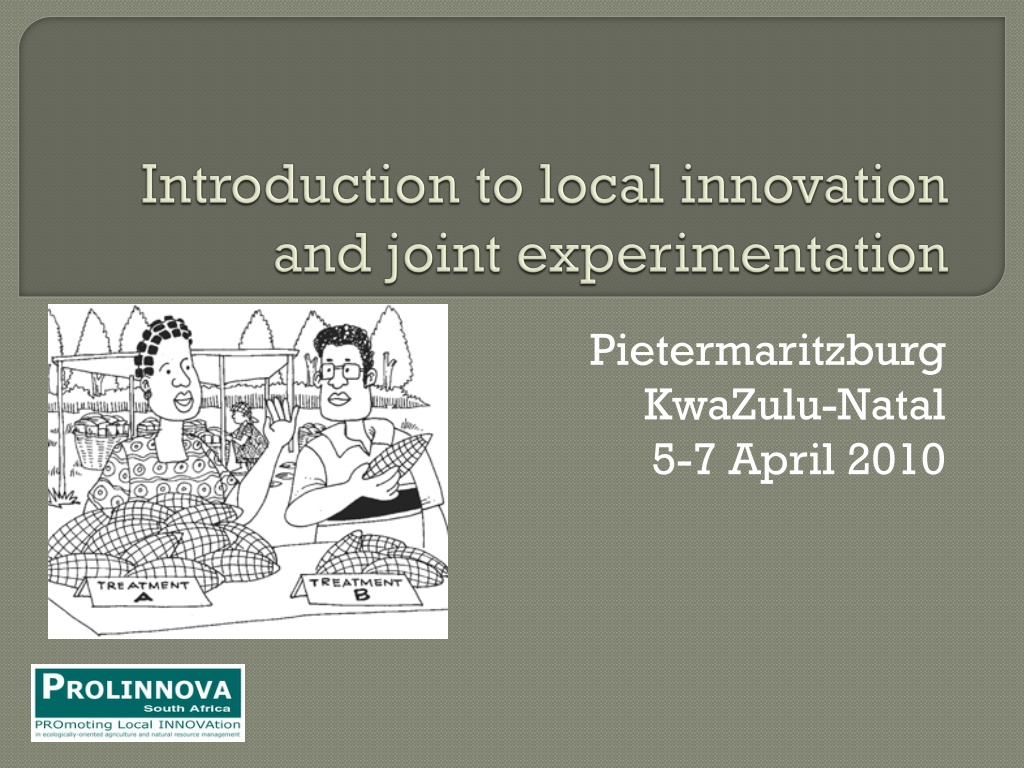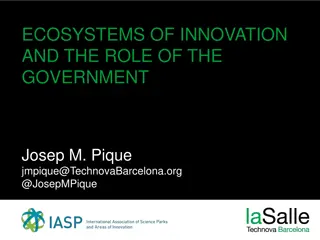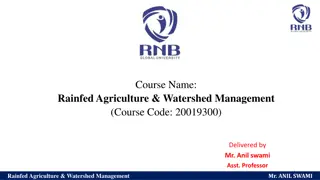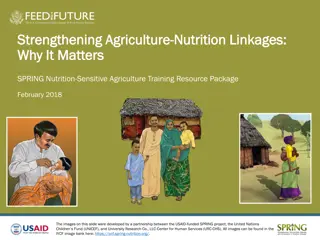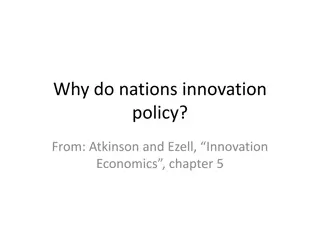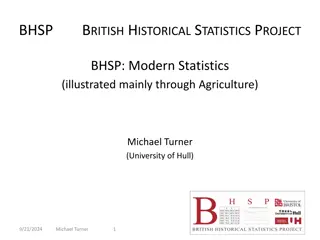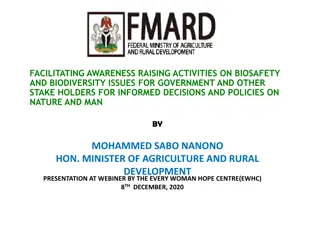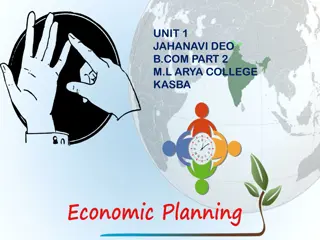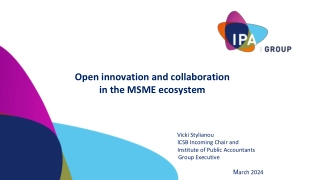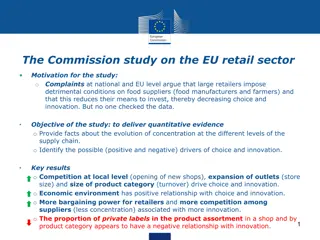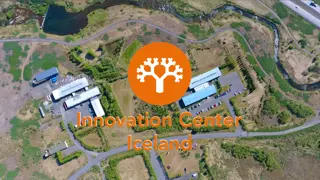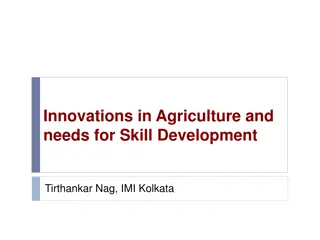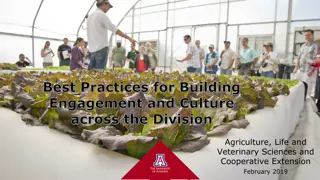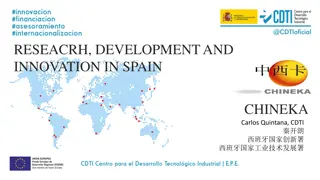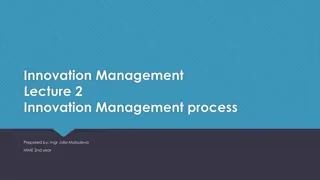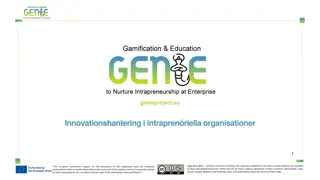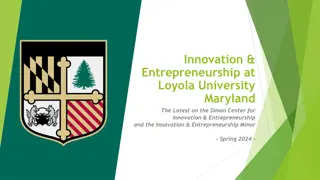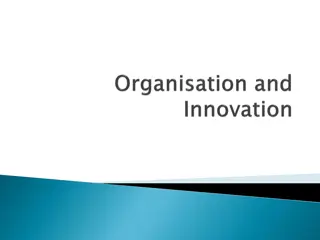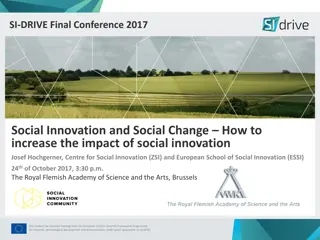Understanding Local Innovation in Agriculture
Local innovation in agriculture involves farmers developing new methods and approaches using locally available resources, leading to technical or non-technical advancements. Innovators, such as farmers and land users, drive this process by improving production methods and management approaches. This community-based knowledge evolves over time, adapting to changing conditions and integrating new tools and skills to address emerging challenges. Collaboration with innovative individuals enhances research and extension programs, encouraging experimentation and knowledge exchange.
Download Presentation

Please find below an Image/Link to download the presentation.
The content on the website is provided AS IS for your information and personal use only. It may not be sold, licensed, or shared on other websites without obtaining consent from the author. Download presentation by click this link. If you encounter any issues during the download, it is possible that the publisher has removed the file from their server.
E N D
Presentation Transcript
Pietermaritzburg KwaZulu-Natal 5-7 April 2010
It is the process by which farmers, without support from R&D agents, discover or develop new and better ways of doing things using the locally available resources Generally it is a process of building on the local knowledge of an area by using new ideas from various sources, including farmers own creativity The outcomes of this process are called local innovations
Local innovation can be either technical or non-technical Technical innovation could involve development of equipment, agricultural practices, value adding practices, etc Non-technical innovation or social innovation can involve ways that people organise themselves, make changes to cultural behaviour or gender roles, etc
Who is an innovator? Innovators are those people (in our case farmers and land users) who develop these new production methods or management approaches in order to improve their lives, their communities and/or their natural environment Research and extension programmes can benefit from working with innovative people who bring their own ideas about how to address a particular problem or capture an opportunity In the extension context, all farmers can be encouraged to try things out and exchange their experiences / outcomes
Its a knowledge that people in a given community have developed over time, and continue to develop. It s developed within a specific context and is thus suited to those particular conditions (both the social and physical aspects).
Its dynamic and changes over time as people find ways of improving it. Changes are made in order to make it more appropriate to emerging challenges, opportunities and conditions. New tools, skills and knowledge that are encountered are integrated and thus results into changes.
The process of finding new things and ways that work and which are compatible with culturally- based local knowledge systems The often unreflected knowledge of villagers about their complex situation is combined with external knowledge, which includes scientific knowledge Outcomes of PID innovations that improve livelihoods and competence for self-reliant local experimentation and action PID is an approach to development that strengthens farmers capacity to test and experiment on their own PID strengthens the capacity of resource users to analyse ongoing processes and develop relevant innovations fitted for new conditions and opportunities -this includes institutional development
Other terms that can be used: Farmer-led participatory research and development Farmer-led joint investigation Farmer-led joint experimentation It is a participatory process where R&D agents work with farmers to improve existing innovations or develop new ones, and where farmers actively participate in directing, planning, implementing and evaluating the process. PID is where research and development programmes are based on things that rural people are already trying out or ideas that they might have about how to improve their livelihood systems - it builds on existing ideas and motivations
PID could involve Joint experimentation (e.g. determining which fertilizer application rate produces the best results) Improving a piece of equipment so that it is easier to use or works better (e.g. trying different materials or making adjustments to a plough) PID is not just about developing new technologies it could involve trying out and developing a new system or way of organising things (e.g. for marketing produce or sharing information) soft innovations
Relationship building with the community Identification of innovators (And local innovation processes) Looking for things to try Screen ideas whether they are cost effective, simple, accessible, will yield results, whether people are willing to try them out Decide what is to be done, who will do it, duration, expected output Trying out (development and implementation of simple experiments that can be managed by the farmers themselves) This should also strengthen farmers capacity to design, implement and evaluate their own experiments Select the farmer-experimenters (local innovators), involve local experts Provide basic training for innovators in experimental methods (how to plan and design simple trials, management, site selection, measurements, analysis of results) Set up the trials (develop criteria for experiment objectives, location, controls, treatments, timing, types of records to be kept, measurements to be made (how, when, who), external assistance required) Follow-up activities (management of the trials, monitoring, participatory assessment, exchange visits, record-keeping) 1. 2. 3. 4.
Evaluation This begins when the trials are set up, is done by individual experimenters as well as farmer groups Overall evaluation at the end of the experiment (based on the criteria used in setting up the trial), and involves deciding the next course of action to be taken (Adoption, recommendation, modification) Dissemination of the results Farmer tours, group meetings, field days, farmer-to-farmer training, development of audio-visuals, manuals, etc Sustaining the process institutionalising experimentation and joint learning processes (through establishment of forums such field days, farmer-to-farmer visits) 5. 6. 7.
What do we mean by experimentation? the testing of an idea the act of conducting a controlled test or investigation (wordnetweb.princeton.edu/perl/webwn) A test under controlled conditions that is made to demonstrate a known truth, examine the validity of a hypothesis, or determine the efficacy of something previously untried. (http://www.answers.com/topic/experiment) A set of actions and observations, performed to verify or falsify a hypothesis or to research a causal relationship between phenomena (en.wiktionary.org/wiki/experimentation)
Local innovation Indigenous knowledge Participatory innovation development Experimentation A trial Joint experimentation Farmer-led Participatory
Exploration where you try out something new and cannot predict the results Hypothesis testing where you are testing something where you already have an idea of the result that you will obtain (you are really testing your assumptions) Verification confirming that something really works Demonstration Showing the benefit of a certain practice or product - The difference between a demonstration and an experiment is that the farmer doing the demonstration follows given recommendations and is assured of success whereas with an experiment the result could be positive or negative
Treatment this is the conditions (combination of factors) that you are testing (e.g. levels of fertilizer) Control the baseline against which we can compare the treatment effect Replicates how many times we repeat a particular treatment in the experiment
Significance of results is one treatment really producing a better result than another is there a real difference? Probability - If I increase fertilizer rate and get an increased yield, is the effect random or is it really due to the treatment? If we say that variety A yields more than variety B (p<0.05), this means that there is a 5% chance that the result is actually just a random effect. If you repeated the experiment 100 times, then in 95 of the experiments you would get the same result. We introduce a number of replications of a particular treatment to be able to prove that the effect of a treatment applied is actually due to the treatment and not due to random effect. Standard error - how much variation is there around the mean?
Have clear hypotheses / objectives what is being tested and why? What is the expected cause-effect relationship We expect that if we do this such and such will occur Replicable testing procedures What conditions must be taken into account as they are likely to influence the outcome of the experiment? This will affect location, timing, etc for example Systematic evaluation Farmers must be able to explain the criteria they used and the information on which they based their conclusion
Practical experience from Potshini Why the need for joint experimentation?
The focus is on experiments that farmers can manage and evaluate themselves and which give results on which farmers can base sound decisions Before joint experimentation, farmers and scientist agree on a research agenda based on local priorities to avoid the danger of scientists defining the experiments and imposing them on farmers
Frequently there is a lack of uptake of technologies Research sometimes does not focus on farmers priorities Assessment is sometimes based on criteria that are not important to farmers Farmers own experimentation allows adaptation to new situations and to improve their livelihoods
Farmers often conduct informal experiments with certain components of technologies that are introduced by extension agents (e.g. if package involves seed, fertilizer and certain planting practices, farmers may just test one component) Research led by farmers aims at exploring new possibilities for solving local problems affecting their livelihood the experiments need to be only scientific enough to produce results that are useful to farmers as a contribution to development rather than to science. PID can happen where development agents work with farmers even when no researchers are involved
Analyse the case study provided, answering the following questions: 1. What is the topic of the experiment? 2. What did the experimenters want to investigate? 3. Why did they want to investigate this (the underlying problem / opportunity to be addressed? 4. What exactly did they want to find out? What question was the experiment answering? 5. How did they design the experiment? (What treatments and how many replicates?) 6. What did they measure? 7. How did they record the data collected? 8. What were the roles of the different stakeholders? 9. Would men and women have equal use for the findings of the experiment? Would they have had the same views of the outcomes? 10. How did they disseminate the results of the experiment?
1. Generate ideas (things to experiment with) 2. Prepare idea sheets capture ideas so that they are not lost 3. Prepare experiment sheets how and why the experiment is to be done (at the experimental design workshop) 4. Prepare an action plan the nature of the experiment is clear to all, responsibilities and time schedules are clear to all, should stay with the experimenter with copy with the field worker 5. Prepare recording books
Collect data Keep a journal farmers and others have record of things that have been discussed and decided upon, and a record of events (drought, hail, etc) Prepare status reports to keep all parties informed of progress Analyse the results of the experiment 10. Evaluate the overall experimentation process 11. Prepare final report - all lessons learnt are available for sharing, covering what was done, the outcomes, farmers recommendation, assessment of researcher, suggestions for further experiments based on this experience, indications regarding other reports/material concerning the experiment available 6. 7. 8. 9.
Find opportunities for integrating farmers and outsiders knowledge and their ideas when seeking solutions Facilitate group discussion about the agenda for experimentation (what is to be tried out and why)
It changes the way potential partners see each others it serves as a tool for learning to understand and value what farmers are already trying to do, builds mutual respect and lays a sound basis for a partnership It provides a point of departure for joint exploration and learning that is firmly embedded in local realities PID takes a positive approach that starts with local ideas and achievements it focuses on local people s strengths and explores particular opportunities open to them, rather then dwelling on their problems such as when a problem analysis is undertaken as an entry point PID can be an approach to extension officers able to encourage farmers to try out and improve the ways they do things rather than trying to convince them to use technologies that have not been tested locally
Bring farmers together to discuss how they will design and implement the experiments Discuss how previous experiments were done Choose farmer experimenters (all or a few) Discuss organisation and timing of experiment when should one start the experiment, what inputs are needs, do all farmers start together? M&E what info do we need to collect, who will do what and when?
Idea sheet Topic What we want to investigate Why we want to investigate this Experiment sheet Topic What we want to investigate Why exactly we want to investigate this (the underlying problem / opportunity / the benefit if the experiment is successful) What exactly we want to find out (the questions that the experiment should answer) The design of the experiment What we need to know if we are to be able to tell if the experiment was successful Sources of additional information regarding the experiment Action / activity plan Activity timing & duration materials required persons/organisations responsible
Name of experiment What will be done Reasons for doing experiment Questions that will be answered Expected results Assessment and evaluation Criteria for measurement General evaluation Action plan (table) Activity Months Materials Resp. 1 2 3 4 5 6 7 Data collect. X X X
Individual application of new equipment or method farmers can come together at intervals to share their findings Paired comparison of two groups of animals or two plots with different treatments (the lots or the groups of animals must be similar so just the treatment is a variable) Before and after experiment instead of comparing two groups or two plots, compare situation afterwards with baseline situation Stepwise or add-on design one trial includes various innovations each being one step towards a full technical package so farmers can evaluate the effect of each addition
The design links a replicated within site researcher-led mother trial, which is conducted at a central location, with one site one replica farmer-led trials The baby trials are located on farmers fields and are designed and managed by farmers they allow for comparison of a sub-set of technologies or varieties One can have a range of treatments at mother trial (fertilizer, legumes, manure, manure/fertilizer combinations etc) then farmers select a few to try at their homes
Find a suitable location - similar to farm situation, uniform, protected Limit experimental plot size - dependent on type of crop and type of experiment When deciding on plot size, consider things such as methods used to determine yield is it fairly rough and does it require substantial differences to be noticed? Ensure good demarcation and separation of plots Eliminate border effects (exclude outside plants / rows)
Carry out experiments on a small scale because: it reduces risk It allows farmer to conduct several experiments simultaneously The rest of the field can serve as a natural control plot It allows poorer farmers to participate in testing technologies Key concept - Keep everything constant across treatments (e.g. plant spacing and weeding) so that you can be sure that the response you see is actually due to the treatment being applied Allow for a control against which to compare the experiment Due to the possibility of distorting circumstances, one year of experimentation is rarely enough to justify adoption of a new technology
Use several replications on one site or replicate across sites Normally avoid replications within fields and rather make them across farms that are spatially clustered so that participating farmers can visit each other to observe and discuss their experiments Limit the number of issues or variables being tested - initially have only one factor or variable in an experiment Ensure systematic monitoring or data collection what information must be collected so one can draw conclusions from the experiment?
Dont get carried away when designing experiments for farmers to manage Let the farmer own the experiment don t pay the farmer for their time or provide free inputs! Be simple and easy design experiments so that they address the major factor first Be flexible and allow for later adaptation (accept that some farmers are likely to drop out) Make sure it is to lead to visible and significant results so don t let plots be too small Calculate costs and benefits of each treatment together with the farmers
You want to look at the impact of weeding frequency (once over the growing season; twice over the growing season; monthly) on maize yields How can you lay out your trial to include 3 replications of each treatment What will you use as a control?
If something is to be learnt from experiments, the results must be well analysed To be able to do this during and after an experiment, data must be recorded in some form Need to look for ways to make data collection and recording more systematic Support farmers so that they can record and assess their own experiments (outsiders can collect additional information) Farmers criteria may be economic, socio- cultural or technical
Methods of collecting information Farmer record sheets, Farmer maps, Group observations and ranking exercises Information-gathering must be cost effective Farmers must be able to understand and use the information collected Study existing practices used for keeping records and assessing experiments then look for ways to make this more systematic Farmers should also identify (and record) any specific circumstances that could have distorted the trials
What is the objective what do you want to learn from the experiment whether cowpea variety A is better than local variety What criteria should be used to assess an experiment with this objective whether it has increased productivity What indicators will show whether these criteria have been met? Yield (kg/ha) What do we measure to find the indicators? Area of the plot, total production from the plot How do we measure these (what techniques of observation and measurement, what equipment needed?) Tins produced, mass of seed produced How will the data be recorded? So we can refer to it later Recording forms, notebooks
Data analysis is done using qualitative and quantitative methods and different people (for different purposes) Farmer might want to know which variety does best on his farm Regional planner will be interested in average performances in order to be able to make recommendations Present data on graphs or in tables Formal statistical analysis allows measures of precision and interpretation of complex interactions
Comparing costs and benefits what is needed to carry out the treatment, what costs are involved what are the effects and the estimated value of the benefits then compare. A partial analysis - Focus on the aspects that differ between the treatments When analysing the effects of an experiment also take into account the development of the whole farm and the wider system does it solve or create other problems, does it make the farm more or less susceptible to droughts, etc
Participatory evaluation of the research results has the experiment achieved its purpose? This should be based on criteria that farmers set to evaluate the results and data that have been collected can involve bringing farmers together at sites to share Evaluate based on the objective of the experiment (e.g. to increase productivity) Prepare for the next round of experimentation how could we have strengthened what we did, what results might be valuable for others, what experiments should we repeat, what other options should we try out next time?
If you apply 100 kg/ha you get a yield of 200 kg, an application of 150 kg/ha yields 250kg and an application of 200kg/ha gives a yield of 300 kg/ha. The fertilizer costs R25/kg and R5/kg for transport. The vegetables will be sold at R35/kg. What is the cost of each fertilizer application? What is the benefit of the additional yield?
Provides useful explanations of results Provide insights into reasons for the variations in results across sites or plots Bring in other factors that are of importance to them (e.g. trade-off between yields and taste) Different members of a community or household will have different criteria for assessing a technology, for example: What claims does the technology put on my scarce resources? What external inputs do I need What are the benefits compared with what I m doing now? How certain is it that these benefits will accrue to me? How will others in my community react when I use this technology? What other effects will application of this technology have on my farm or within my community?
Farmer-to-farmer visits Exchange visits between farmer innovators Visitors by farmers to farmer innovators (and vice versa) Dissemination to other stakeholders? Scientists, policy makers
M&E can strengthen the learning, accountability and effectiveness of research efforts In monitoring the focus is on seeing whether the research has been implemented smoothly and identifying problems and issues emerging (i.e. monitoring the experimentation process according to the action plan) The M&E activities should not only cover the innovation being developed, but also the process of strengthening local capacities to innovate
